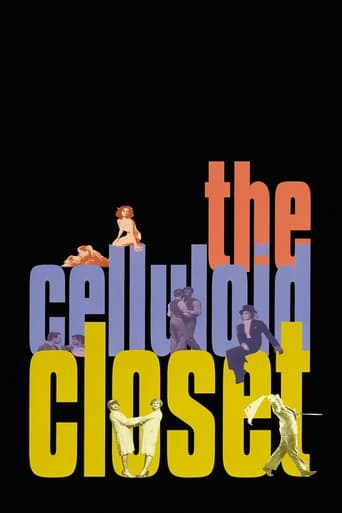

Favourite movie-clip quote from Cary Grant - ".... Because I just went gay all of a sudden!" Whether you happen to be gay, lesbian, straight, or whoever - I certainly think that this documentary (which takes a close-up look at the role of the homosexual character in mainstream cinema) is sure to be of some relevant interest and appeal to a fair-sized audience.Through interviews with Hollywood celebrities, and gay screenwriters, filmmakers, and historians - As well as a non-stop procession of choice film-clips, spanning from 1895-1995 - The Celluloid Closet thoroughly covers the first 100 years of the "gay/lesbian" character in cinema, where, according to some of the interviewees here - "Negative representation was better than nothing." If you ask me - I think that one of the best moments in "The Celluloid Closet" was in a scene taken from 1959's "Pillow Talk" (a very silly Rom-Com) where actor Rock Hudson (a "real-life" gay man) plays a straight man impersonating a gay man. This charade was all done, of course, in order to get a woman into bed.*Note* - Keep in mind that "The Celluloid Closet" is now 20 years old.
... View MoreThe Celluloid Closet is well-put-together documentary style film that does an excellent job in revealing how homosexuals were portrayed in Hollywood. The narration, along with movie clips, served as both informative and entertaining; with a perfect balance. It was informative enough to be taken seriously, yet at the same time, entertaining enough that the documentary was interesting, if not fascinating.In terms of organization, the film is very orderly and sequential. It starts with the early 1900s and proceeds to move forward till the late 1900s. I must also compliment the way the movie effectively compares and contrasts portrayals of homosexuals in different time periods, allowing for a smooth and easy to follow transition.What I loved most about the film is that it also features the varying opinions of different actors (such as Tom Hanks, Whoopie Goldberg, Tony Curtis, and others). This gives a wider variety of insight than just your own thought on watching the small movie clips.Although I do recommend the film, I did hope to see more on how the movies mentioned in the film became accepted. Another complaint is that the film lacked information on the directors or actors that should be given credit for exposing queer films into the public (especially during the early-mid 1900s when homosexuality wasn't socially acceptable). Overall, this is a great documentary for any gender or sex, whether you're homosexual or heterosexual.
... View More"The Celluloid Closet", released in 1995, gives a keen insight into the history of homosexuals depicted in the art of film. This documentary has a great set up of commentators. They are all qualified to be speaking on the subject matter. Names and job descriptions are all given in the documentary. A younger audience can even recognize commentators such as Whoopi Goldberg and Tom Hanks. There is a sneak peek into the political influence on film production. The classic movie "Ben-Hur" released in 1959 and directed by William Wyler, is just one of the examples given for film with underlying homosexual influences. This justifies the use of "Closet" in the title. In many of the films used in the documentary the sexuality of the characters is not directly addressed, but none the less evident after watching "The Celluloid Closet". The documentary follows the changing social views of sexuality and what is acceptable chronologically, all the way from black and white films to colored films. Watching this documentary is sure to enlighten the viewer, and would be helpful to all who would like to have a better understanding of homosexuality in relation to films and film production. While being very informative the documentary is also enjoyable and engaging.
... View More"The Celluloid Closet" was an overall great documentary on how homosexuality has evolved in film over decades of movies. In the early 1930s the film explained how movies portray homosexuality to be humorous. The actors that played the gay role were called "Sissies" subliminally portraying to the audience that they are homosexuals.As the movie progressed it had displayed other aspects on how the community now pictured homosexuals. The "Hayes Code" was created to rate movies on how appropriate they were. The Catholic Church as well joined in the process of rating by evaluating certain films to see if the movie was "appropriate" by their religious standards. Films later depicted homosexuals as villains such as Dracula's sister forcing the main actress to undress in front of her. In Albert Hitchcock the two villain murderers were homosexuals as well. At a certain point in these movies they had many gay subliminal symbols that the censors did not understand. During the 40s queer film was progressing to different degree. "The Celluloid Closet" explained that seeming gay was almost as bad as being gay. There would be films that would criticize a character for walking a certain way or even saying certain words. The screenwriter of Rebel without a cause stated that he would make the main character to be displayed as a gay outcast if it were during the millennium time period. In the 50's and 60's many characters of films were obviously gay. The first film to admit the homosexual intention was "The Victim" in 1961. Although there was a steadily progress of queer film, homosexuality was then presented as a crime. In the queer films the gay character would end up dying whether it be by a hero slaying the homosexual, or they became depressed and committed suicide. Queer film over the last four decades has evolved from a mental illness to being presented a sign of affection and love. Now in the 20th century queer film is accepted in the theaters almost everywhere in the nation.
... View More